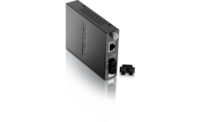Regardless what type of connectors (LC, SC or ST) and what size fiber (50, 62.5 or 9 micron) there are three ways to test the functionality of a new or existing fiber link. Technicians can use a flashlight/laser, Optical Loss Test Set (OLTS) or an Optical Time Domain Reflectometer (OTDR).
Each of these testers have their functions and advantages as well as disadvantages. A basic principle of fiber optics is that some form of visible light can pass through a fiber link end to end. This is a no-go test because if the light doesn’t reach the far end there is a break in the fiber link, which usually will indicate one or two bad connectors that need replacement. A standard flashlight can be used, but because it emits white light it can be hard to see at the far end if the fiber is long, and often it is difficult to align the fiber tip (the ferrule) onto a standard flashlight effectively. The visual red laser is much easier to use because they come equipped with adapters that allow the fiber tip to be fully inserted, and the red light is much easier to see at the far end.
Red laser fiber optic testers can also indicate fiber strand breakage near the connector as the powerful 5- or 10-milliwatt laser lights will escape from a broken or tightly bent fiber showing the location of a problem that needs repair. As is illustrated in the top photo, a laser fiber tester can be used to test connectors by connecting the laser and very gently bending the fiber close to the connector. If the laser light is visible, the connector passes light and is probably okay.
While the visible light/laser is a no-go test, the OLTS and OTDR testers can provide a measurement of the quality of the fiber link and are more comprehensive than using a flashlight. These sophisticated testers are readily available, but they can be costly.
While the quality of a fiber link is very important for high-bandwidth data transmissions, in our industry the typical IP cameras transmit using 10/100 Ethernet, which is a relatively pedestrian protocol today.
Some fiber links can be 100 meters in length. To perform these tests, two technicians are needed — one injecting the light or laser and the other at the far end verifying visually that the light passes through. This could double labor costs for contractors.
However, I will tell you the secret to having a single tech visually test fiber links. When using multimode fiber, any type of Ethernet is usually transmitted and received using two separate fiber optic links. So, if the technician has either a pre-made fiber jumper or one of the pre-made jumper plugs along with some inexpensive fiber adapters illustrated in the bottom photo, fiber testing can be performed by a single person. First, go to the far end of the links and connect either the jumper or the mini jumper to both fiber links to be tested, making sure you clean them first.
Go back to the other end and connect the fiber link to the visible light source. If you can see the light as looped back through the two fiber links you have verified that the fibers and their connectors do indeed pass light and are likely functional for IP cameras, intercoms, speakers, etc. While these testing methods do not correspond with networking industry standards, they provide enough information for the purposes of most low-voltage applications.







